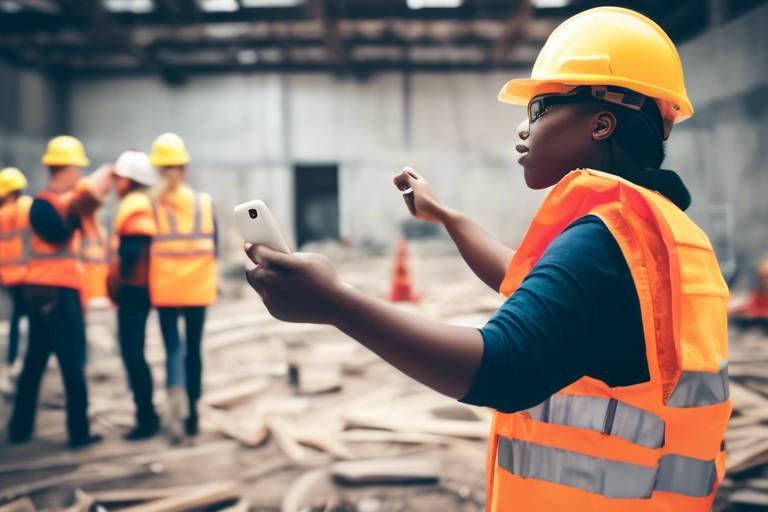Seven Steps to Personal Safety at Work
In today's fast-paced work environment, ensuring personal safety is more crucial than ever. Employees often find themselves navigating through various challenges, from physical hazards to emotional stressors. But fear not! By following seven essential steps, you can significantly enhance your safety and well-being at work. These steps are not just about compliance; they are about creating a culture of safety that benefits everyone in the workplace. So, buckle up as we dive into the details of how you can take control of your safety and that of your colleagues!
The first step in ensuring safety is to recognize potential hazards that may lurk in your work environment. Workplace hazards can be classified into several categories, including physical, chemical, ergonomic, and psychosocial risks. For instance, a cluttered workspace can lead to trips and falls, while exposure to harmful chemicals can pose serious health risks. By being vigilant and aware of your surroundings, you can identify these dangers before they escalate into accidents. It's like being a detective, always on the lookout for clues that could indicate a potential threat to your safety.
Imagine a fire breaks out in your office—what would you do? Having a clear emergency preparedness plan can be the difference between chaos and safety. An effective emergency plan outlines the steps to take during various crises, whether it's a fire, earthquake, or even a medical emergency. It’s essential to know not only what to do but also who to call and where to go. This plan should be communicated to all employees and reviewed regularly to ensure everyone is on the same page. Remember, preparation is key, and being ready can save lives!
An evacuation plan is your roadmap in times of crisis. It should detail the routes to take and the procedures to follow when evacuating the premises. To create an efficient evacuation strategy, consider the following:
- Identify all possible exit routes.
- Designate a meeting point outside the building.
- Ensure all employees are aware of the plan.
By having a well-thought-out evacuation plan, you can ensure that everyone knows exactly what to do when the situation becomes urgent.
Clearly marked emergency exits are vital during any crisis. Signage should be visible and easy to understand, guiding employees swiftly towards safety. Best practices for signage include:
- Using bright colors that stand out.
- Ensuring exits are free from obstructions.
- Regularly checking that all exit signs are illuminated and functioning.
When every second counts, having accessible exits can make all the difference in ensuring a swift evacuation.
Just like athletes practice to enhance their performance, employees should regularly participate in emergency drills. These drills help familiarize everyone with safety protocols and can significantly reduce panic during real emergencies. Schedule drills at least twice a year, and consider varying the scenarios to keep everyone on their toes. Remember, practice makes perfect!
Proper ergonomics is not just a buzzword; it’s a vital aspect of workplace safety that can prevent injuries and enhance productivity. An ergonomic workspace is designed to fit the needs of the user, promoting comfort and efficiency. Simple adjustments, such as using chairs that provide back support, arranging monitors at eye level, and taking regular breaks to stretch, can make a world of difference. Think of your workspace as a well-tuned machine—every part needs to work in harmony to function effectively.
Open communication is essential for a safe workplace. Employees should feel empowered to report safety issues without fear of retaliation. Encouraging a culture of transparency can lead to quicker resolutions and a safer environment for everyone. It’s like having a safety net; when everyone is looking out for one another, the workplace becomes a much safer place.
A clear reporting system is crucial in empowering employees to voice their concerns. This system should be straightforward, confidential, and easily accessible. Consider implementing an online platform or suggestion box where employees can anonymously report safety issues. Regularly review and address these concerns to show that management is committed to maintaining a safe workplace.
Promoting a culture of safety is about more than just policies; it's about fostering an environment where safety is a shared responsibility. Encourage employees to participate in safety committees, recognize safe practices, and celebrate safety milestones. When safety becomes part of your workplace's DNA, everyone benefits.
Ongoing training is crucial for maintaining workplace safety. Regular safety workshops and training sessions keep employees informed about the latest safety protocols and best practices. Think of it as a continuous learning journey—just like you wouldn’t stop studying after school, safety education should be an ongoing process.
Conducting regular workshops helps keep safety knowledge fresh. Organize interactive sessions that engage employees in discussions and activities related to safety. This not only enhances their understanding but also builds a community focused on safety.
Access to safety resources enhances employee awareness. Make sure to provide various tools and materials, such as safety manuals, posters, and online resources, to support workplace safety initiatives. When employees are equipped with the right information, they become more proactive in maintaining a safe environment.
Q: What should I do if I notice a safety hazard?
A: Report it immediately to your supervisor or use the established reporting system.
Q: How often should emergency drills be conducted?
A: It's recommended to conduct drills at least twice a year to ensure everyone is familiar with the procedures.
Q: What resources are available for workplace safety training?
A: Many organizations provide safety manuals, online courses, and workshops to help employees stay informed about safety practices.

Understanding Workplace Hazards
When it comes to ensuring safety in the workplace, the first step is to recognize potential hazards. Understanding these dangers is akin to having a map before embarking on a journey; without it, you could easily find yourself lost in a sea of risks. Workplace hazards can take many forms, from physical dangers like slippery floors to environmental threats such as exposure to harmful chemicals. By identifying these hazards, employees can take proactive steps to mitigate risks and create a safer work environment.
Common workplace hazards can be categorized into several types:
- Physical Hazards: These include anything that can cause physical harm, such as machinery, tools, and even the layout of the workspace itself. For instance, cluttered walkways can lead to trips and falls.
- Chemical Hazards: Exposure to harmful substances is a significant risk in many industries. Chemicals can be found in cleaning supplies, manufacturing processes, and even in the air we breathe.
- Biological Hazards: These are related to exposure to bacteria, viruses, and other living organisms that can cause health issues. This is especially relevant in healthcare settings.
- Ergonomic Hazards: Poor workstation design can lead to repetitive strain injuries. It's essential to assess how employees interact with their environment to prevent these issues.
- Psychosocial Hazards: Stress, harassment, and workplace bullying can affect mental health and overall job satisfaction. Recognizing these hazards is just as important as identifying physical dangers.
To effectively identify these hazards, employees should engage in regular workplace assessments. This can include:
- Conducting walk-through inspections to spot potential risks.
- Encouraging open discussions about safety concerns among colleagues.
- Utilizing checklists to ensure all areas are covered during assessments.
Moreover, it’s crucial to foster a culture where everyone feels comfortable reporting hazards. When employees are empowered to voice their concerns, it creates a collaborative environment focused on safety. Think of it as a team sport where everyone plays a role in keeping the team safe. In a workplace where safety is prioritized, employees are not just passive observers; they become active participants in their own protection.
In conclusion, understanding workplace hazards is not just about recognizing what could go wrong; it’s about taking action to prevent those risks from becoming reality. By being vigilant and proactive, employees can help create a safer workplace for themselves and their colleagues, ultimately leading to a more productive and harmonious work environment.

Emergency Preparedness Plans
Having a clear emergency preparedness plan is not just a checkbox on a corporate checklist; it’s a lifeline that can save lives and protect your colleagues. Imagine being in a situation where every second counts—having a well-thought-out plan can make all the difference. So, what does an effective emergency plan look like? It involves a combination of clear communication, defined roles, and regular practice. Each workplace is unique, and understanding the specific risks associated with your environment is crucial. Whether it’s a fire, natural disaster, or medical emergency, the key components of your plan should be tailored to address these scenarios.
One of the most vital aspects of an emergency preparedness plan is that it involves everyone in the workplace. From management to entry-level employees, everyone should know their role when disaster strikes. This collective awareness not only enhances safety but also fosters a sense of community and responsibility. Think of it as a well-rehearsed play; every actor knows their lines and cues, which leads to a smooth performance, even under pressure.
Moreover, an effective emergency preparedness plan should include the following critical elements:
- Risk Assessment: Identify potential hazards specific to your workplace.
- Communication Plan: Establish how information will be disseminated during an emergency.
- Resource Allocation: Determine what resources (first aid kits, fire extinguishers, etc.) are available and where they are located.
- Training and Drills: Regularly train employees on emergency procedures and conduct drills to ensure everyone is prepared.
Additionally, it’s essential to have a designated team responsible for overseeing emergency preparedness. This team should regularly review and update the plan, ensuring it remains relevant and effective. Consider this team as the guardians of safety—always vigilant and ready to act. They can also serve as a point of contact for any questions or concerns employees may have about the plan.
One of the cornerstones of any emergency preparedness plan is a well-structured evacuation plan. This plan should clearly outline the steps employees need to take in the event of an emergency. It’s not just about getting out; it’s about getting out safely and efficiently. The evacuation plan should include designated meeting points where employees can gather once they are outside the building. This ensures that everyone is accounted for and minimizes confusion.
Emergency exits should be clearly marked and easily accessible. Think of these exits as the lifelines that lead to safety. Signs should be visible from all areas of the workplace, and pathways to these exits should be free of any obstacles. Regular checks should be conducted to ensure that these exits remain clear and functional. Remember, in a crisis, every second counts, and having a clear path can save lives.
Regular emergency drills are essential for keeping safety protocols fresh in everyone’s mind. These drills not only familiarize employees with the evacuation procedures but also help to identify any weaknesses in the plan. Just like a fire drill in school, practicing these scenarios can reduce panic and confusion during a real emergency. Make it a point to schedule these drills at least twice a year, and consider varying the times to ensure all shifts are included.
In conclusion, an effective emergency preparedness plan is a vital component of workplace safety. By recognizing the importance of clear communication, designated roles, and regular practice, you can create a culture of safety that empowers everyone in the organization. Remember, the goal is not just to have a plan but to ensure that every employee feels confident in their ability to respond in an emergency.
Q: Why is an emergency preparedness plan important?
A: It prepares employees for potential emergencies, ensuring their safety and the safety of others.
Q: How often should we conduct emergency drills?
A: It is recommended to conduct drills at least twice a year.
Q: What should be included in an evacuation plan?
A: Clear exit routes, designated meeting points, and roles for employees during an evacuation.

Creating an Evacuation Plan
When it comes to workplace safety, having a solid evacuation plan is not just a good idea—it's essential. Imagine a fire alarm blaring or an earthquake shaking the ground beneath you. In those critical moments, every second counts, and knowing exactly what to do can make all the difference between chaos and a smooth evacuation. So, how do you go about creating an effective evacuation plan that everyone can understand and follow?
First, start by assessing your workplace layout. This means taking a good look at the entire area and identifying the most efficient routes for evacuation. Consider the following factors:
- Number of exits: Ensure there are enough exits for everyone to leave quickly.
- Obstructions: Identify any obstacles that could hinder a swift evacuation, such as furniture or equipment.
- Accessibility: Make sure exits are accessible to all employees, including those with disabilities.
Once you have a clear understanding of your space, the next step is to design the evacuation routes. Use clear and concise language in your evacuation plan. This plan should include:
| Component | Description |
|---|---|
| Primary Evacuation Routes | The main paths employees should take to exit the building. |
| Secondary Routes | Alternative paths in case the primary routes are blocked. |
| Assembly Points | Designated safe areas where everyone should gather after evacuating. |
Next, communicate the plan effectively. It's not enough to just create the plan; you need to make sure every employee is aware of it. This can be achieved through:
- Training sessions that explain the evacuation procedures.
- Visual aids, such as maps and posters, displayed prominently throughout the workplace.
- Regular reminders via emails or meetings to keep the evacuation plan fresh in everyone's minds.
Another critical aspect of an effective evacuation plan is to conduct regular drills. Think of it like a fire drill at school; the more you practice, the more natural it becomes. Drills help to familiarize everyone with the evacuation routes and procedures, ensuring that when the time comes, employees can act quickly and confidently. Schedule these drills at least twice a year, and don’t forget to evaluate their effectiveness after each one. Gather feedback from participants to improve the plan continuously.
Finally, review and update your evacuation plan regularly. As your workplace changes—whether through renovations, new employees, or changes in equipment—so too should your evacuation plan. Make it a habit to review the plan at least once a year or whenever a significant change occurs. This proactive approach ensures that your plan remains relevant and effective, keeping everyone safe in case of an emergency.
In conclusion, a well-thought-out evacuation plan is a cornerstone of workplace safety. By assessing your layout, designing clear routes, communicating effectively, conducting drills, and regularly updating the plan, you create an environment where safety is prioritized, and everyone knows exactly what to do in an emergency.
Q: How often should we conduct evacuation drills?
A: It's recommended to conduct evacuation drills at least twice a year to keep everyone familiar with the procedures.
Q: What should I do if I notice a blocked exit?
A: Report any obstructions to your supervisor immediately so they can address the issue and ensure a clear evacuation route.
Q: Can I suggest changes to the evacuation plan?
A: Absolutely! Employee feedback is invaluable for improving safety protocols, so don’t hesitate to share your thoughts.

Designating Emergency Exits
In any workplace, the importance of cannot be overstated. When an emergency strikes, every second counts, and having clear, accessible exits can make the difference between safety and chaos. Imagine being in a crowded office when the fire alarm blares—panic can set in quickly. This is why it's crucial to have emergency exits that are not only identified but also easily reachable.
To ensure that all employees know where to go in an emergency, it’s essential to implement best practices for signage and exit accessibility. Start by placing clear and visible signs at key points throughout the workplace, especially in areas where visibility might be compromised, such as hallways or near large equipment. These signs should be illuminated and made of durable materials to withstand various conditions. Additionally, consider using universal symbols that can be understood by everyone, regardless of language barriers.
Accessibility is another critical factor. Emergency exits should be free from obstructions at all times. This means regularly checking that furniture, equipment, or even cleaning supplies do not block these pathways. A good practice is to conduct monthly checks to ensure that all emergency exits remain clear and that signage is intact and visible.
Furthermore, it’s beneficial to create a map of emergency exits that can be distributed to all employees. This map should highlight all available exits and the safest routes to reach them during an emergency. You might even consider posting these maps in common areas such as break rooms or near elevators. Here’s a simple example of what your exit map could look like:
+-----------------+ | | | [Exit 1] | | | | | | [Exit 2] | | | | | | [Exit 3] | | | +-----------------+
Finally, regular training sessions should include information on emergency exit locations. Employees should feel confident navigating the space, even in low visibility situations. Remember, the goal is to create an environment where everyone knows the safest path to safety without hesitation. By taking these steps to designate emergency exits effectively, you're not just meeting safety regulations; you're fostering a culture of preparedness that can save lives.

Conducting Drills Regularly
When it comes to workplace safety, one of the most effective strategies is conducting regular drills. You might think of drills as just another chore on your to-do list, but in reality, they are your best friend when it comes to preparedness. Imagine being in a situation where every second counts, and you’re fumbling around trying to remember what to do. That’s not just stressful; it can be dangerous. Regular drills ensure that everyone knows the plan and can execute it efficiently.
So, why should you prioritize these drills? First and foremost, they help to familiarize employees with the emergency procedures. When an alarm goes off, the last thing you want is confusion. Regular practice turns what could be a chaotic moment into a well-orchestrated response. Think of it as a fire drill for your brain—repeated exposure makes the actions almost instinctive.
Moreover, drills can highlight potential weaknesses in your emergency response plan. Maybe the exit routes are blocked, or the assembly point is unclear. By running through these scenarios, you can identify and rectify issues before they become real problems. It’s like a dress rehearsal before the big show; you want everything to go smoothly when the curtain rises.
To make the most out of your drills, consider the following tips:
- Vary the Scenarios: Don’t just run the same fire drill every time. Mix it up with different emergency situations—like a chemical spill or an active shooter scenario. This keeps everyone on their toes and prepares them for various emergencies.
- Involve Everyone: Make sure that all employees, regardless of their role, participate in the drills. This builds a sense of community and shared responsibility for safety.
- Debrief After Each Drill: Take time to discuss what went well and what could be improved. This feedback loop is crucial for ongoing safety improvements.
Remember, the goal of conducting drills regularly isn’t just to check a box on a compliance form; it's about creating a culture of safety where everyone feels empowered to act. The more comfortable your employees feel with the procedures, the more likely they are to respond effectively in a real emergency. It’s not just about following orders; it’s about building confidence and teamwork.
In conclusion, regular drills are a vital component of workplace safety. They not only prepare employees but also foster a proactive attitude towards safety. So, gather your team, schedule those drills, and make safety a priority. After all, it’s better to be prepared than to be caught off guard when it matters the most.
- How often should we conduct safety drills? It's recommended to conduct drills at least twice a year, but more frequent drills may be necessary depending on the workplace environment.
- What types of drills should we include? Include a variety of scenarios such as fire evacuations, earthquake preparedness, and lockdown situations to ensure comprehensive training.
- How do we evaluate the effectiveness of our drills? After each drill, hold a debriefing session to discuss what went well and what needs improvement. This feedback is crucial for refining your emergency response plan.

Workplace Ergonomics
When we talk about , we're diving into the fascinating world of designing our workspaces to fit our bodies and not the other way around. Imagine sitting at your desk for hours on end, hunched over your keyboard like a pretzel. Not only does it feel uncomfortable, but it can lead to long-term health issues like chronic pain or repetitive strain injuries. That's where ergonomics comes in. By implementing ergonomic principles, we can create a workspace that promotes comfort and efficiency, allowing us to work smarter, not harder.
So, what does a well-designed ergonomic workspace look like? It starts with the basics: your chair, desk, and computer setup. A good ergonomic chair should support your lower back and allow your feet to rest flat on the floor. If your feet dangle like a child on a swing, it’s time to adjust! Similarly, your desk should be at a height that lets your elbows rest comfortably at a 90-degree angle while typing. If you find yourself reaching or straining, it’s a sign that your setup needs a tweak.
Let’s not forget about your computer monitor. Ideally, the top of the screen should be at or just below eye level, ensuring you don’t have to crane your neck like a giraffe to see it. A simple trick is to place your monitor about an arm's length away from your eyes. This setup minimizes strain and keeps you focused on your tasks without unnecessary discomfort.
But ergonomics isn’t just about physical setups; it’s also about how we interact with our environment. Taking regular breaks to stretch and move around can do wonders for your body and mind. Think of it as hitting the refresh button on your computer. Just as your device needs a break to function optimally, so do you! Set a timer to remind yourself to get up, walk around, or do some quick stretches every hour.
To summarize, here are some key ergonomic tips to keep in mind:
- Adjust your chair for proper lumbar support.
- Keep your feet flat on the floor or on a footrest.
- Position your monitor at eye level to avoid neck strain.
- Take regular breaks to stretch and move.
By making these small adjustments, you can significantly improve your comfort and productivity at work. Remember, a well-designed ergonomic workspace isn’t just a luxury; it’s a necessity for maintaining your health and well-being in the long run. So, let’s embrace ergonomics and create a workspace that not only looks good but feels good too!
Q: What are the signs that my workspace is not ergonomic?
A: Common signs include discomfort in your back, neck, or wrists, frequent headaches, and fatigue. If you notice any of these symptoms, it might be time to reassess your workspace setup.
Q: How often should I take breaks for stretching?
A: It's recommended to take a break every hour for about 5-10 minutes. This helps to reduce muscle tension and refresh your focus.
Q: Can I improve my ergonomics without purchasing new furniture?
A: Absolutely! Simple adjustments like repositioning your monitor, using cushions for lumbar support, or even changing your sitting posture can make a big difference.
Q: Are there any specific exercises that can help with workplace ergonomics?
A: Yes, exercises such as shoulder rolls, wrist stretches, and neck tilts can help alleviate tension and improve flexibility. Incorporating these into your daily routine can be very beneficial.

Reporting Safety Concerns
In any workplace, ensuring safety is a shared responsibility. It's not just the job of the management; every employee must play their part. One of the most effective ways to maintain a safe environment is by encouraging individuals to report safety concerns. Imagine working in a place where everyone feels empowered to speak up about potential hazards. This culture not only protects individuals but also fosters teamwork and trust among colleagues.
When employees are encouraged to voice their concerns, it creates an atmosphere where safety is prioritized. But how do we create this environment? First, it’s essential to establish a robust reporting system. This system should be straightforward, allowing employees to report issues without fear of retaliation. A well-structured reporting mechanism can include various channels such as anonymous hotlines, suggestion boxes, or dedicated safety officers. These options give employees the confidence to report issues, knowing their voices will be heard.
Moreover, it’s crucial to communicate the importance of reporting safety concerns. Employees should understand that reporting is not just about pointing out problems; it’s about contributing to a safer workplace for everyone. Regular meetings or training sessions can be an excellent opportunity to discuss this topic. In these sessions, employees can share their experiences and learn from one another, further reinforcing the significance of safety reporting.
To illustrate the importance of a reporting system, consider the following table that outlines key elements of an effective safety reporting mechanism:
| Element | Description |
|---|---|
| Accessibility | The system should be easy to access, with multiple reporting options available. |
| Anonymity | Employees should have the option to report concerns anonymously to encourage openness. |
| Feedback | Provide feedback to employees who report issues, showing that their concerns are taken seriously. |
| Follow-up | Ensure there is a follow-up process in place to address reported concerns promptly. |
Additionally, fostering a safety culture goes hand-in-hand with reporting. When employees see that their concerns lead to action, it reinforces the idea that safety is a priority. This can be achieved through recognition programs that celebrate individuals or teams who actively contribute to safety improvements. For example, consider implementing a “Safety Champion” award that acknowledges employees who consistently report hazards or suggest improvements. Such initiatives can motivate others to follow suit.
In conclusion, creating an environment where safety concerns are reported without hesitation is vital for any organization. It requires a commitment from both management and employees to cultivate a culture of safety. By establishing a clear reporting system and promoting open communication, companies can ensure that everyone plays a part in maintaining a safe workplace. Remember, safety is not just a policy; it’s a practice that thrives on collective effort.
- Why is it important to report safety concerns? Reporting safety concerns helps identify and mitigate risks before they lead to accidents or injuries.
- What should I do if I notice a safety hazard? Report it immediately through the established reporting system, whether it’s to a supervisor or via an anonymous channel.
- Will I face repercussions for reporting a safety issue? No, reporting safety concerns should be encouraged and protected by company policy to ensure a safe working environment.
- How can management support safety reporting? Management can support safety reporting by providing training, resources, and a transparent process for addressing concerns.

Establishing a Reporting System
Creating an effective reporting system is pivotal in fostering a safe workplace environment. When employees feel empowered to voice their safety concerns, it not only helps in identifying potential hazards but also promotes a culture of transparency and trust. Imagine a workplace where everyone is vigilant and aware, with a clear channel to report issues—this is the essence of a robust reporting system.
To establish such a system, it's crucial to start by defining the reporting process. Employees need to know exactly how to report their concerns, whether it's through an online platform, a physical suggestion box, or direct communication with a designated safety officer. This process should be simple and accessible to everyone, ensuring that no one feels intimidated or hesitant to speak up.
Moreover, consider implementing an anonymous reporting option. This can significantly increase the likelihood of employees coming forward with their concerns, especially if they fear repercussions. By allowing anonymity, you create a safe space for open dialogue about safety issues that might otherwise go unreported. It’s like having a safety net that catches issues before they escalate into serious problems.
Additionally, it's essential to provide training on how to use the reporting system effectively. Employees should be educated on what types of issues to report and the importance of doing so promptly. Regular workshops or informational sessions can keep safety at the forefront of employees' minds, reminding them that their input is not only valued but necessary for a safe workplace.
Once a report is made, it’s vital to have a clear protocol for how these concerns will be addressed. Establishing a timeline for responses and actions taken ensures that employees feel heard and that their issues are being taken seriously. Transparency in this process builds trust, as employees see that their reports lead to tangible changes. You might consider a simple table to outline the reporting process:
| Step | Action | Timeline |
|---|---|---|
| 1 | Report Issue | Immediately |
| 2 | Review Report | Within 48 hours |
| 3 | Investigate | Within 5 days |
| 4 | Implement Solutions | As needed |
| 5 | Follow-up | Within 2 weeks |
Finally, regularly review and update the reporting system based on feedback from employees and any changes in workplace dynamics. This ensures that the system remains effective and relevant. Remember, a reporting system is not a one-time setup; it requires continuous improvement and adaptation to meet the needs of your workforce.
- What types of issues should be reported? Any safety concern, near misses, or hazards that could potentially lead to injury or accidents.
- Can I report an issue anonymously? Yes, providing an anonymous reporting option is highly recommended to encourage openness.
- How will I know my report was addressed? A clear follow-up process will be in place, ensuring that you receive updates on the status of your report.
- What if I feel uncomfortable reporting to my supervisor? You can use the anonymous reporting method or report to another designated safety officer.

Encouraging a Safety Culture
Creating a safety culture in the workplace is not merely a checkbox on a compliance list; it’s a dynamic and ongoing commitment that involves every employee, from the top executives down to the newest hires. Think of it like planting a garden: you need to nurture it regularly for it to thrive. This means fostering an environment where safety is a shared responsibility, and everyone feels empowered to contribute. But how do we cultivate this culture?
First and foremost, communication is key. Open lines of communication allow employees to voice their concerns without fear of reprisal. When employees feel heard, it builds trust and encourages them to speak up about potential hazards or unsafe practices. Regular safety meetings can serve as a platform for discussing safety issues, sharing experiences, and brainstorming solutions. It’s like having a team huddle where everyone can share their game plan for staying safe.
Moreover, recognizing and rewarding safe behavior can significantly boost morale and motivate employees to prioritize safety. Consider implementing a safety recognition program where employees are acknowledged for their commitment to maintaining a safe workplace. This could include:
- Monthly awards for the safest team or individual
- Public recognition during company meetings
- Incentives such as gift cards or extra time off
Additionally, training plays a crucial role in embedding safety into the company culture. Regular training sessions not only keep safety protocols fresh in everyone’s mind but also demonstrate that the organization is serious about safety. When employees are equipped with the knowledge and skills necessary to handle various situations, they are more likely to take proactive steps to ensure their own safety and that of their colleagues.
Lastly, leadership involvement cannot be overstated. When leaders model safe behavior and actively participate in safety initiatives, it sends a strong message that safety is a priority. Employees are more likely to adopt a safety-first mindset when they see their leaders walking the talk. It’s like a captain steering a ship; if the captain is vigilant about navigating safely, the crew will follow suit.
In summary, encouraging a safety culture is about creating an environment where safety is everyone's responsibility. By fostering open communication, recognizing safe behavior, providing ongoing training, and demonstrating leadership commitment, organizations can cultivate a culture that not only prioritizes safety but also enhances overall workplace morale and productivity.
Here are some common questions regarding encouraging a safety culture in the workplace:
- What is a safety culture? A safety culture refers to the shared values, beliefs, and practices regarding safety within an organization.
- Why is it important to have a safety culture? A strong safety culture can reduce accidents, improve employee morale, and enhance overall productivity.
- How can I encourage my team to prioritize safety? Encourage open communication, recognize safe practices, and provide regular training to keep safety at the forefront of everyone’s mind.

Training and Education
Ongoing training is crucial for maintaining workplace safety. It’s not just about having the right equipment or protocols; it’s about ensuring that every employee is equipped with the knowledge and skills they need to navigate potential hazards. Think of training as a safety net—without it, employees might find themselves in precarious situations, unsure of how to react. Regular training sessions can significantly enhance awareness and preparedness, leading to a more secure work environment.
To effectively implement a training program, organizations should consider various types of training that cater to different needs. For instance, new employee orientation should include safety protocols specific to their roles and the workplace environment. Additionally, refresher courses for existing employees are essential to keep safety practices fresh in their minds. Just like how athletes practice regularly to keep their skills sharp, employees too need ongoing training to stay alert and informed about safety procedures.
Here are some key components that should be included in any robust training program:
- Regular Safety Workshops: Conducting regular workshops keeps safety knowledge fresh. These sessions can cover a range of topics, from emergency response to proper equipment handling.
- Hands-On Training: Practical training sessions allow employees to experience real-life scenarios in a controlled environment. This can boost their confidence and readiness during actual emergencies.
- Utilizing Safety Resources: Access to various safety resources, such as manuals, online courses, and safety videos, enhances employee awareness and understanding of safety practices.
Moreover, it’s vital to create a feedback loop where employees can share their experiences and suggest improvements to the training process. This not only empowers employees but also helps in tailoring the training programs to meet the actual needs of the workforce. When employees feel their voices are heard, they are more likely to engage actively in safety practices, creating a culture of safety that permeates the entire organization.
In conclusion, investing in training and education is not just a regulatory requirement, but a moral obligation to ensure that every employee feels safe and prepared. A well-trained workforce is a confident workforce, and confidence is key to preventing accidents and injuries on the job.
Q1: How often should safety training be conducted?
A1: Safety training should be conducted regularly, with new employee orientation sessions, annual refresher courses, and additional training as needed based on changing conditions or incidents.
Q2: What topics should be covered in safety training?
A2: Training should cover emergency procedures, proper equipment use, ergonomics, and reporting safety concerns, among other relevant topics specific to the workplace.
Q3: How can I encourage my coworkers to participate in safety training?
A3: Highlight the benefits of safety training, such as increased confidence and preparedness, and create an engaging environment that makes learning enjoyable.

Regular Safety Workshops
When it comes to workplace safety, knowledge is power. That's why are not just a good idea; they're essential! Imagine walking into a room where everyone is engaged, learning how to handle potential hazards, and discussing real-life scenarios. This is the kind of environment that workshops can create, and it’s all about empowering employees with the necessary skills and knowledge to keep themselves and their colleagues safe.
These workshops serve multiple purposes. First and foremost, they help in refreshing safety knowledge. Even if employees have undergone training before, it's easy to forget important protocols over time. By conducting regular sessions, you ensure that everyone is up-to-date with the latest safety procedures and regulations. Think of it as a tune-up for your car; regular maintenance keeps everything running smoothly, and the same goes for workplace safety.
Moreover, workshops can be tailored to address specific issues relevant to your workplace. For instance, if your team works with hazardous materials, a workshop focused on handling these substances safely can be incredibly beneficial. Here’s a quick breakdown of what a typical safety workshop might include:
| Workshop Component | Description |
|---|---|
| Introduction to Safety Protocols | A refresher on existing safety guidelines and procedures. |
| Hands-on Training | Practical demonstrations of safety equipment and emergency responses. |
| Real-life Scenarios | Group discussions on past incidents and how they could have been avoided. |
| Q&A Session | An open forum for employees to ask questions and clarify doubts. |
It's also important to foster an interactive atmosphere during these workshops. Engaging employees through discussions, role-playing, and even gamification can make the learning process enjoyable. When employees are actively involved, they are more likely to retain the information shared. After all, who doesn’t remember a fun game or an interesting discussion?
Another key aspect of these workshops is the opportunity for employees to voice their concerns or suggestions regarding safety measures. This feedback is invaluable as it can lead to the identification of potential hazards that may not have been previously considered. In this way, regular workshops not only educate but also promote a culture of safety where everyone feels responsible for maintaining a safe work environment.
In conclusion, regular safety workshops are a cornerstone of workplace safety initiatives. They keep safety knowledge fresh, engage employees, and create an open dialogue about safety concerns. By investing time and resources into these workshops, you are not only complying with safety regulations but also showing that you care about the well-being of your employees. So, why not schedule your next safety workshop today? It could make all the difference in creating a safer workplace.
- How often should safety workshops be conducted? It's recommended to hold safety workshops at least once every quarter, but more frequent sessions may be beneficial depending on the industry.
- Who should lead the workshops? Ideally, workshops should be led by a qualified safety officer or an external expert with experience in workplace safety.
- What topics should be covered in safety workshops? Topics can vary based on the workplace but should include emergency procedures, equipment handling, and injury prevention strategies.
- Are safety workshops mandatory? While not always legally required, they are highly encouraged to ensure a safe working environment and compliance with safety regulations.

Utilizing Safety Resources
In today’s fast-paced work environment, is more critical than ever. These resources not only help in identifying potential hazards but also equip employees with the necessary tools and knowledge to mitigate risks effectively. Think of these resources as your safety toolbox; just like a carpenter wouldn’t dream of starting a project without their tools, employees shouldn’t navigate their workplace without the right safety resources.
First and foremost, organizations should ensure that employees have access to comprehensive safety manuals. These manuals serve as a go-to guide for understanding workplace protocols, emergency procedures, and safety regulations. It’s essential that these manuals are not just available but are also regularly updated to reflect any changes in safety policies or procedures. Imagine trying to fix a car with outdated instructions—frustrating, right? The same principle applies to safety manuals.
Another vital resource is the availability of personal protective equipment (PPE). Depending on the nature of the work, this could include helmets, gloves, masks, or goggles. Ensuring that employees are equipped with the right PPE is not just a legal obligation; it’s a fundamental aspect of workplace safety. Just like a knight wouldn’t go into battle without armor, employees should not face hazardous tasks unprotected.
Furthermore, companies should invest in online safety training programs. These programs can be tailored to fit the specific needs of the organization and can cover a wide range of topics, from basic safety protocols to specialized training for high-risk jobs. Online training offers flexibility, allowing employees to learn at their own pace, which can be incredibly beneficial in retaining information. When employees feel confident in their training, they are more likely to act decisively in a crisis.
In addition, maintaining a safety resource library can significantly enhance safety awareness among employees. This library can include a variety of materials, such as brochures, videos, and interactive modules that cover different aspects of workplace safety. Having a central location for these resources encourages employees to seek out information proactively, fostering a culture of safety. Think of it as a treasure chest of information waiting to be explored!
Lastly, it’s essential to promote the use of mobile safety apps. These applications can provide real-time safety alerts, access to emergency contacts, and even instructional videos on how to handle specific situations. Just like having a GPS for navigating unfamiliar territory, these apps can guide employees through potential hazards and emergency scenarios with ease.
In conclusion, utilizing safety resources is not just about compliance; it’s about creating a workplace where employees feel empowered and protected. By investing in comprehensive manuals, PPE, online training, resource libraries, and mobile apps, organizations can foster a culture of safety that not only meets regulatory standards but also promotes employee well-being. Remember, a safe workplace is a productive workplace!
- What are safety resources? Safety resources are tools, materials, and training programs that help employees identify and mitigate workplace hazards.
- Why are safety manuals important? They provide essential guidelines and protocols for ensuring safety and compliance in the workplace.
- How can online training benefit employees? Online training offers flexibility and allows employees to learn at their own pace, which helps in better retention of safety knowledge.
- What role does PPE play in workplace safety? PPE protects employees from potential hazards, reducing the risk of injury during tasks that involve exposure to dangerous conditions.
Frequently Asked Questions
- What are some common workplace hazards?
Common workplace hazards include slips, trips, and falls, electrical hazards, ergonomic issues, and exposure to harmful substances. Recognizing these dangers is the first step in ensuring a safe work environment.
- Why is having an emergency preparedness plan important?
An emergency preparedness plan is crucial because it can save lives during a crisis. It outlines the steps employees should take in case of emergencies, ensuring everyone knows what to do and where to go.
- How can I create an effective evacuation plan?
To create an effective evacuation plan, identify all emergency exits, ensure they are clearly marked, and communicate the plan to all employees. Regular drills will help everyone become familiar with the procedure.
- What should I do if I notice a safety hazard at work?
If you notice a safety hazard, report it immediately to your supervisor or the designated safety officer. Open communication about safety concerns is essential for maintaining a safe workplace.
- How can we encourage a culture of safety in the workplace?
Encouraging a culture of safety involves promoting open communication, providing regular training, and recognizing employees who prioritize safety. This proactive approach helps everyone feel responsible for maintaining a safe environment.
- What types of training programs are necessary for workplace safety?
Essential training programs include emergency response training, ergonomics training, and regular safety workshops. These programs equip employees with the knowledge and skills needed to handle various safety situations.
- How often should safety drills be conducted?
Safety drills should be conducted at least twice a year to ensure that all employees are familiar with emergency procedures. Regular practice helps reinforce the importance of safety and keeps the information fresh in everyone's minds.
- What resources are available to support workplace safety initiatives?
Various resources include safety manuals, online training modules, and access to safety equipment. Utilizing these resources can enhance employee awareness and contribute to a safer workplace.



















